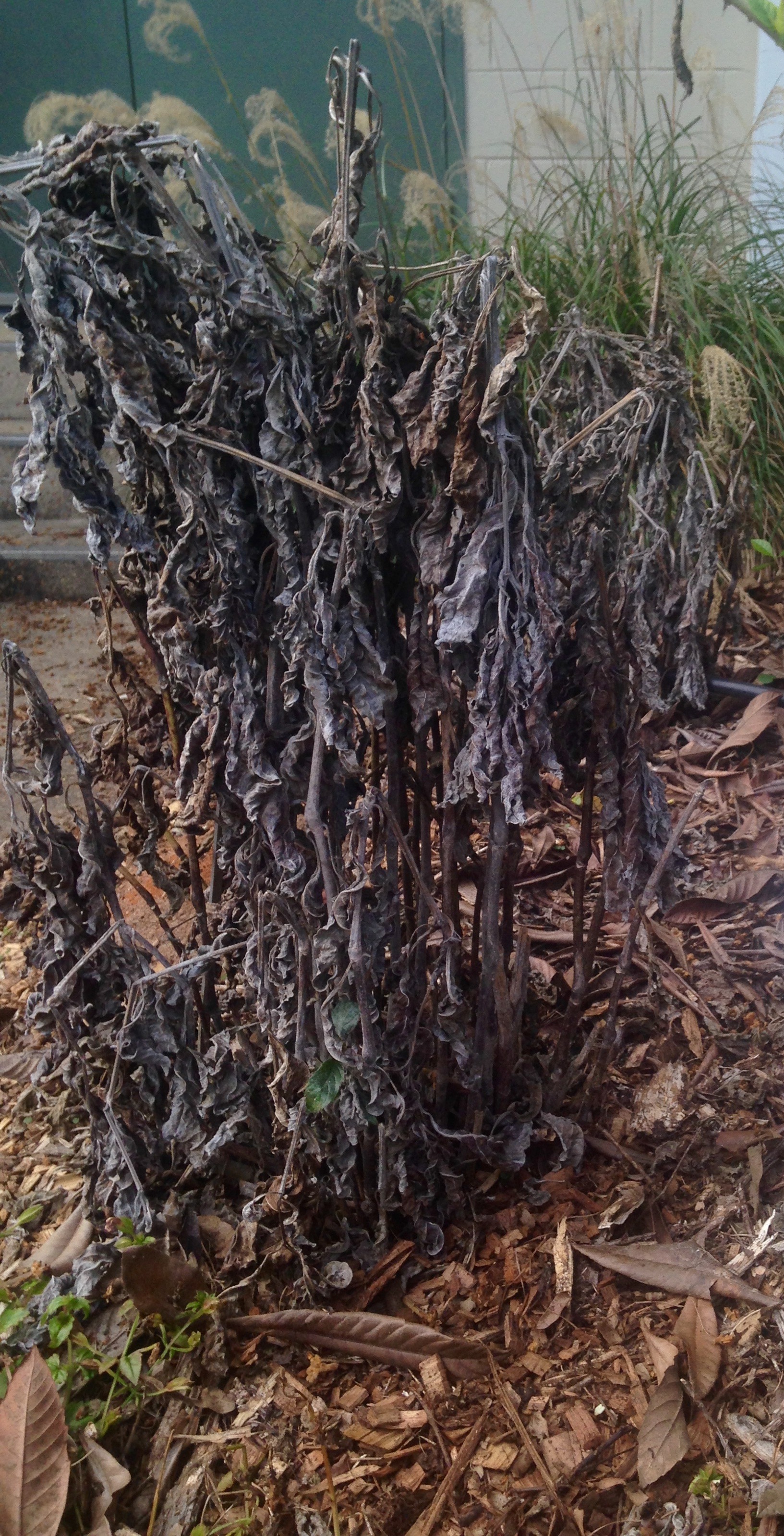
by Sheila Dunning | Dec 23, 2014
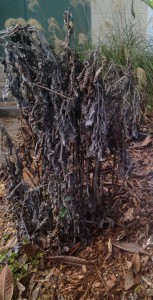
A frozen perennial plant. Photo credit: Taylor Vandiver UF/IFAS Extension.
When you look out at your landscape nobody has to tell you that winter temperatures in Northwest Florida Afterwards, the temperatures warm up and you feel compelled to do something about it. You just need to “turn your back and slam the door”. “Conceal, don’t feel; don’t let them know”. Cold injury can affect the entire plant or just certain plant or parts such as fruits, flowers, buds, leaves, trunks, stems, or roots. Many plant parts can adapt to tolerate cold. Root systems in the landscape are seldom ‘frozen’ in Florida. “The cold never bothered” them “anyway”. While dead, unsightly leaves may be removed as soon as they turn brown after a freeze, the remaining dry looking stems serve as food storage and should be allowed to remain. If they are removed before the weather is warm enough for the plant to resume growth, the root system may not be enough to support the plant and it will die. So, “let it go, let it go, let it go”. “The perfect” landscape “is gone”. “The past is in the past”. “It’s funny how some distance makes everything seem so small”.Tropical plants and summer annuals do not adapt or harden to withstand temperatures below freezing, and many suffer injury at temperatures below 50°F (10°C). Subtropical plants can harden or acclimate (become accustomed to a new climate) to withstand freezing temperatures, and properly conditioned temperate plants can withstand temperatures substantially below freezing.
Recently planted, unestablished plants may be more susceptible to cold injury. One type of winter injury is plant desiccation or drying out. This is characterized by marginal or leaf tip burn in mild cases and totally brown leaves in severe cases. Desiccation occurs when dry winds and solar radiation result in the loss of more water from the leaves than can be absorbed and/or transported by a cold root system. Plant water needs should be checked after a freeze. Plants may have lost substantial moisture during a windy freeze. Plants will transpire (lose water vapor) on a sunny day after a freeze. Cold injured wood can be identified by lightly scraping the bark with your fingernail and examining the color of the cambium layer (food conducting tissue) just underneath. Green tissue indicates the plant is still alive at that point; black or brown coloration indicates dead or injured tissue. 
After a particularly harsh cold event, some plants may be very slow to recover, so some patience is required. “It will rise” with “the break of spring”. Branch tips may be damaged while older wood is free of injury. Delay pruning until new growth appears next spring to ensure that live wood is not removed. In the meantime, take Elsa’s advice and “let it go, let it go, let it go”. You may be “too relieved to grieve”. I hope I haven’t infringed on any copyrights by letting you know “It’s okay to put off the yard work in the name of plant physiology”.
Enjoy the holiday season!
For more information please see:
Treating Cold Damaged Plants
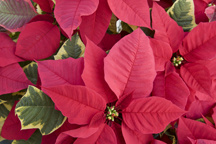
by Gary Knox | Dec 23, 2014
Poinsettias are one of the most popular plants during the Holiday Season. Poinsettias grow as shrubs in their native southern Mexico but have been bred to become compact, bushy plants perfect as container ornamentals. The showy “flowers” of poinsettias are actually modified leaves called bracts. Usually red in color, modern poinsettia breeding created showy bracts ranging in color from red to pink to white to orange, with lots of variegations and different leaf coloration patterns and sizes. The true flowers on poinsettias are the small green and yellow parts located in the center of each group of bracts.

Photo credit: Tyler Jones UF/IFAS.
Here are some do’s and don’ts to ensure that your poinsettias stay beautiful through the holidays and beyond:
- Do choose plants with true flowers that are greenish. Plants with unopened or newly opened flowers will last longer than those already sporting true flowers dusted with yellow pollen.
- Do choose plants that are bushy and leafy. Plants that have lost their lower leaves usually indicate the plant was mishandled and may decline quickly.
- Do place poinsettias in an area with bright light but not direct sunlight.
- Do keep poinsettias away from children and pets. Poinsettias are not poisonous but still might cause skin irritation and upset stomachs. People allergic to latex should be aware poinsettia sap contains latex-like materials.
- Don’t overwater poinsettias. Only water poinsettias when the top of the soil is dry, and let excess water drain away. Remove the poinsettia from the decorative foil wrapping to allow water to drain out.
- Don’t expose poinsettias to temperature extremes or drafty areas. Poinsettias like the same temperatures as people, so keep them away from cold (temperatures below 50) or heat (temperatures above 80).
After the holidays are over, you can plant poinsettias outdoors. For more information see:
Enjoy Your Poinsettias After the Holidays
In the meantime, enjoy your beautiful poinsettias and Happy Holidays!
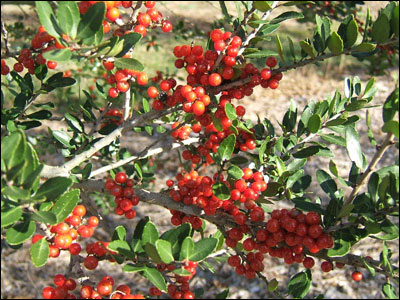
by Taylor Vandiver | Dec 16, 2014
Now that we’ve all been stuffed like a Thanksgiving turkey, it’s time to transition into the final and, arguably, most ornate holidays of the year. Right now you can hear your mantles and door frames crying out to be adorned. Your windows are begging for wreaths and giant red bows. And there may be a certain corner in your house that has been waiting all year for an evergreen, or two.
As we delve into the winter holidays our homes are being dressed to impress. There is nothing better than fresh foliage placed along a mantle or maybe a little mistletoe hanging from a previously unadorned beam. The scent of pine is in the air and I don’t know about you, but I’m ready to get decorating.
Here is a list of a few evergreen plants that make wonderful decorations for the season. You may even find some in your own backyard! Just make sure when you are removing foliage and fruit that you do it gently, so as not to harm the plant. Make all cuts at a 45 degree angle so that water will not pool on branch tips and rot. Also, if you forcefully remove foliage from a plant you could expose the susceptible cambium layer.

Wreaths and a decorated door frame add a bit of holiday cheer to this snowy scene. Photo courtesy Taylor Vandiver.
Traditional
Magnolia (Magnolia grandiflora) – This southern staple provides foliage that will liven up any banister or door frame. After being cut from the tree it can withstand the dryer temperatures indoors for days on end.
Hollies (Ilex spp.) – Hollies not only provide glossy green foliage, but bright red fruit that will beautifully adorn holiday arrangements and centerpieces.
Pine/Pinecones (Pinus spp.) – Pine trees offer a wispy presence to many decorations and their cones can give structure to wreaths and mantle pieces.
Boxwood (Buxus spp.) – Boxwoods are great for a touch of green.

Yaupon holly fruit and foliage. Photo courtesy UF/IFAS.
New Ideas
Abelia (Abelia x grandiflora) (evergreen to semi-evergreen) – Abelia are not commonly thought of when making holiday arrangements, but the texture of their foliage and the myriad of colors can spice up traditional decorations.
Aucuba (Aucuba japonica) – Aucuba offer a coarse texture that would pair well with the wispier pine foliage. Also, the gold dust variety will add a little more color to the mix.
Aspidistra (Aspidistra elatior) – Aspidistra foliage tends to feel more tropical. If you want to try a non-traditional arrangement these would work well and they can last for days provided a small amount of water.
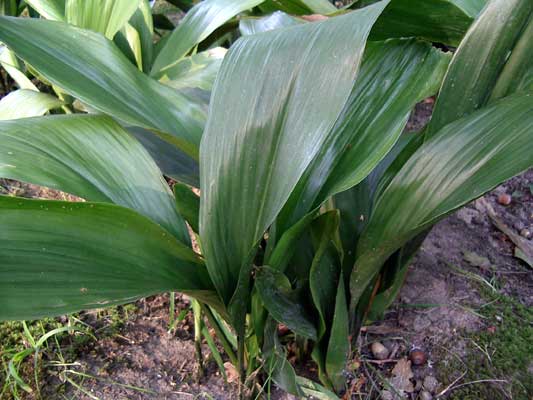
Aspidistra foliage that could easily be worked into a stunning arrangement.
Remember that a few well placed planters can liven up even the smallest spaces. Try using a small evergreen tree or shrub such as a magnolia, cypress / false cypress or arborvitae and surround them with poinsettia or pansies. You can try a smaller planter and add in pine cones, poinsettia, grasses, etc. Also if you are celebrating this holiday season with a live Christmas tree, then don’t be afraid to ask the grower/retail center for discarded branches. These can easily be formed into a wreath or used throughout the house. And since this is Florida there’s always the option of decorating your palm tree!
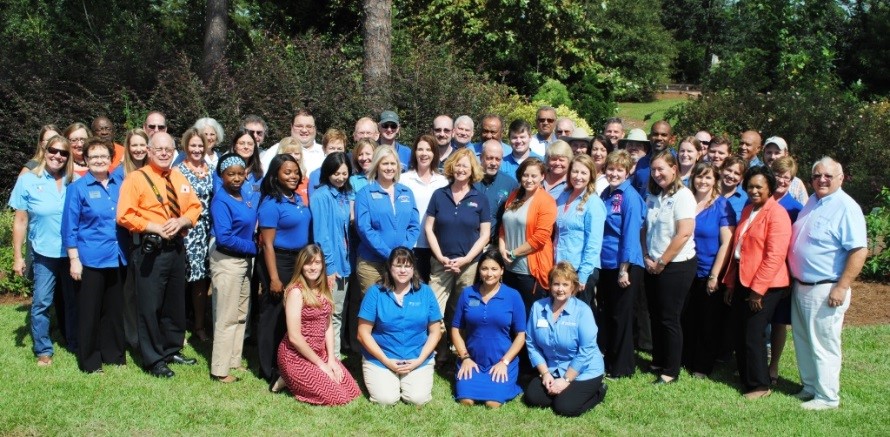
by ifwpadmnwdistrict | Dec 12, 2014
Thank You for a Wonderful Year!

UF/IFAS Northwest Extension District Agents
As we come to the end of our 100th year of serving the citizens of Florida, the University of Florida/IFAS Extension Faculty located in the 16 county offices of the Florida Panhandle thank you for making 2014 another great year!
Extension has come a long way assisting farmers and their families with relevant information since the beginning of the 20th century. Today, 100 years later, UF/IFAS Extension continues to provide science-based information to the citizens of Northwest Florida.
This year our County Extension Faculty provided valuable information and educational programs to 1000’s of individuals, families, businesses, and agricultural producers across the panhandle. As you know, our educational programming includes topics in areas such as Agriculture, Natural Resources, Horticulture, Family and Consumer Sciences, and 4-H Youth Development. UF/IFAS has a Solution for your Life!
We are excited about, and dedicated to providing our clients the most recent and science-based information on a wide range of topics such as:
-
Agricultural production and marketing
-
Providing youth with exciting opportunities that develop life skills, teamwork, and responsibility
-
Food preservation, cooking
-
Helping individuals and families with health and wellness, parenting and manage budgets
-
Consumer assistance within the home
-
Wildlife and land management
-
Coastal and inland fishery management
-
Home gardening and commercial landscaping
-
Acquiring Continuing Education Units for a variety of licenses
Though the first 100 years of UF/IFAS Extension have been very productive we do not plan on sitting back and resting on the accomplishments of the past. We will continue to provide you and your family the best information and education available to provide “Solutions for Your Life!”
Thank you once again for participating in our Extension programs! We look forward to seeing you in 2015, and as always, if you have a question on any topic, or a suggestion to help us help you better, please do not hesitate to contact us. You can find your local County Extension office on the web at http://nwdistrict.ifas.ufl.edu or Facebook at https://www.facebook.com/IFASNW.
Happy Holidays & Best Wishes for the New Year!
Dr. Pete Vergot III, Professor, and Northwest District Extension Director and your County Extension Faculty and Staff of the UF/IFAS Extension Northwest District serving Panhandle Florida

by Larry Williams | Dec 9, 2014
From about mid November or December to March, deciduous trees have little to no foliage making us more aware of their shapes, forms and barks.
Here are a few trees to consider for adding winter appeal to your landscape.
Gary Knox, UF/IFAS Horticulturist, describes the crapemyrtle’s winter interest perfectly in his publication, “Crapemyrtle in Florida.” Knox writes, “When the leaves fall in winter, the crape myrtle becomes a living sculpture. The trunk and branches of tree-form plants have an attractively gnarled, sinuous character with smooth bark. Strips of bark peel off (exfoliate) in early summer to reveal mottled new bark ranging in color from pale cream to dark cinnamon to rich brown to bright orange.”
Here are some recommendations for crapemyrtles with attractive bark. ‘Acoma’ is an outstanding semi-dwarf hybrid reaching a mature height of 10 to 15 feet that has creamy beige bark and snow white flowers. ‘Apalachee’ is another outstanding selection with cinnamon orange bark and light lavender flowers. Its mature height is about 20 feet. The cultivar ‘Osage’ produces dark orange bark and medium pink flowers with a 20-foot mature height. ‘Fantasy’ is a large maturing variety growing to more than 20 feet tall with outstanding red orange bark and white flowers. More cultivars are listed in Knox’s publication available at http://edis.ifas.ufl.edu/MG266.
River birch is another tree with unusual papery peeling bark. The cultivar ‘Heritage’ is the closest to a paper white birch that will tolerate our hot summers. Expect a river birch to reach 40 to 50 feet in height and 25 to 35 feet in width.
Cultivars of Ulmus parvifo
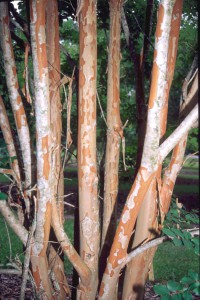
Apalachee Crapemyrtle Bark Photo Credit: UF/IFAS
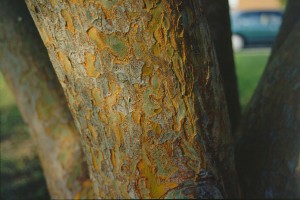
Drake Elm Bark Photo Credit: UF/IFAS
lia, Chinese elm, provide winter interest. “The showy, exfoliating bark reveals random mottled patterns of gray, green, orange and brown, adding great textural and visual interest, especially to its winter silhouette,” writes Ed Gilman, UF/IFAS Horticulturist, in his factsheet on Chinese Elm. This and other tree factsheets are available at http://hort.ifas.ufl.edu/woody. ‘Drake’ and ‘Allee’ are two popular Chinese elm cultivars. Chinese Elm can reach 80 feet in height but is more often seen at 40 to 50 feet with an equal spread.
American Hophornbeam, Ostrya virginiana, is an underused tree that grows to about 50 feet in height. Its grayish bark peels off in longitudinal strips revealing orange patches underneath.
Acer buergeranum or trident maple is a small, underused and hard to find tree. It usually is seen with multiple stems originating fairly low on the trunk giving the small tree a bushy appearance. It has noticeable orange-brown peeling bark.
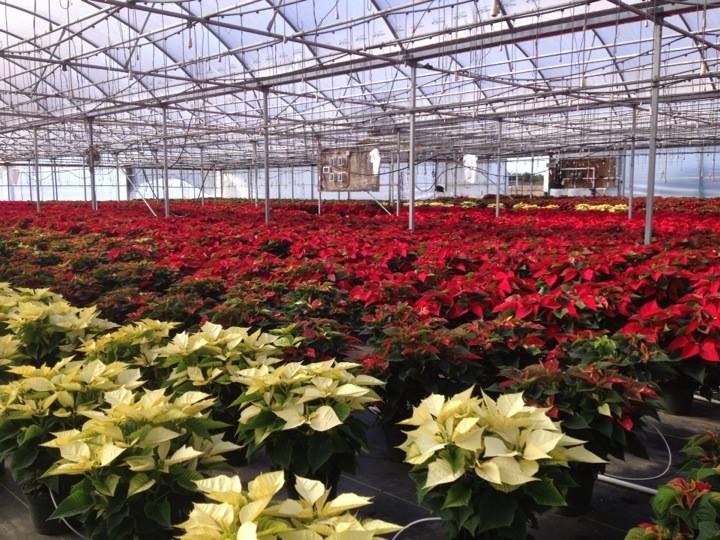
by Eddie Powell | Dec 9, 2014
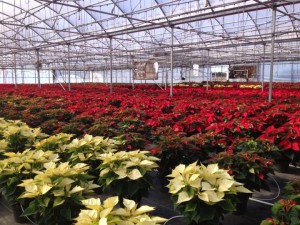
Poinsettia grown in greenhouse
Photo Credits: William Wendt
The poinsettia is a beautiful plant associated with the Christmas holidays. These plants create colorful holiday decorations for any home. After the holidays are over, they can be used as landscape plants.
Poinsettias are non-poisonous and non-toxic. However, some people may be sensitive to the latex in poinsettia sap. Although eating even a large number of leaves will not result in illness, the plant is not considered edible. When used as an indoor plant, it should be kept out of reach of children and pets.
Keep your poinsettias away from drafts and chilly air. Water your poinsettia when the surface of the soil is dry to the touch. Place a saucer under the pot, and drain the saucer if water starts to collect in it. Keep the soil from getting soggy. Gently spray the plants with a mist sprayer or place them on gravel trays. Slightly humid air will help prolong the plants’ color and life span. Do not fertilize your indoor poinsettias until you are ready to move them outside. High levels of fertilizer will reduce the quality of the plant.
When the temperatures start to warm up in spring, trim the fading bracts. Leave 4 to 6 inches of the stem on each branch. Begin using a well-balanced fertilizer, and move the plant outdoors to a somewhat shaded area. Once the poinsettia has acclimated to the outdoors, plant it in an area that receives full sun most of the day. Keep in mind that to put out its colorful bracts, poinsettias require 14 hours of complete darkness each day for 6 to 8 weeks. Any interruption to this dark period can delay or prevent the plant from flowering.
Keep the soil moderately moist at all times. Poinsettias grow best in moist, well drained, fertile soils. The ideal soil pH range is 5.5 to 6.5, but the plants will tolerate a range from 5.0 and 7.0. Fertilize your outdoor poinsettias once a month. In north Florida, the plants should be fertilized between May and September.
In the landscape, prune your poinsettias in early spring after they are finished blooming, and when the danger of frost has passed. Cut them back to within 12 to 18 inches of the ground. If the plants have been frozen below this point, cut them back to the live wood. Pruning during the growing season will produce a compact plant at flowering time. After four weeks or when the new growth is 12 inches long, cut the plant back, leaving four leaves on each shoot.
For more information see: Poinsettias at a Glance
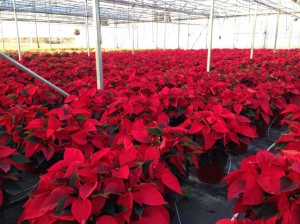
Poinsettia offers awesome Christmas color
Photo Credits: William Wendt














